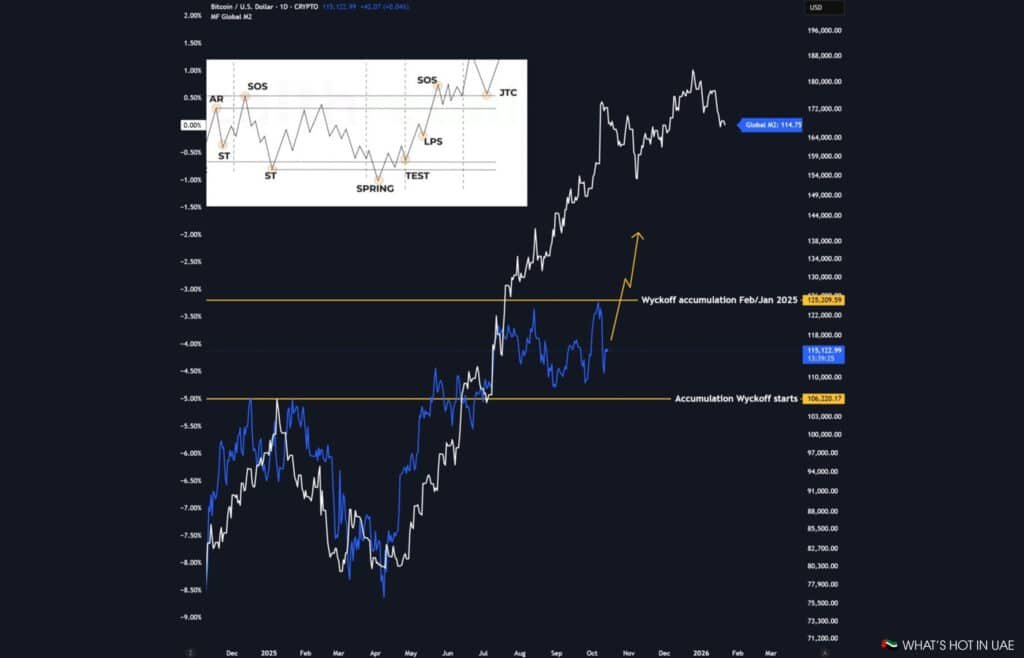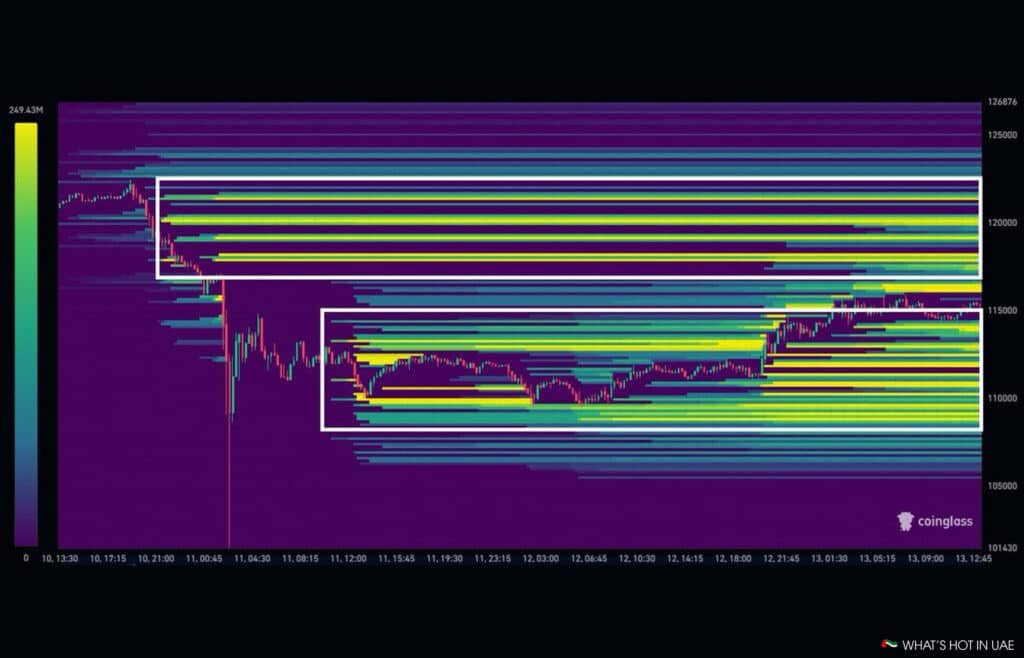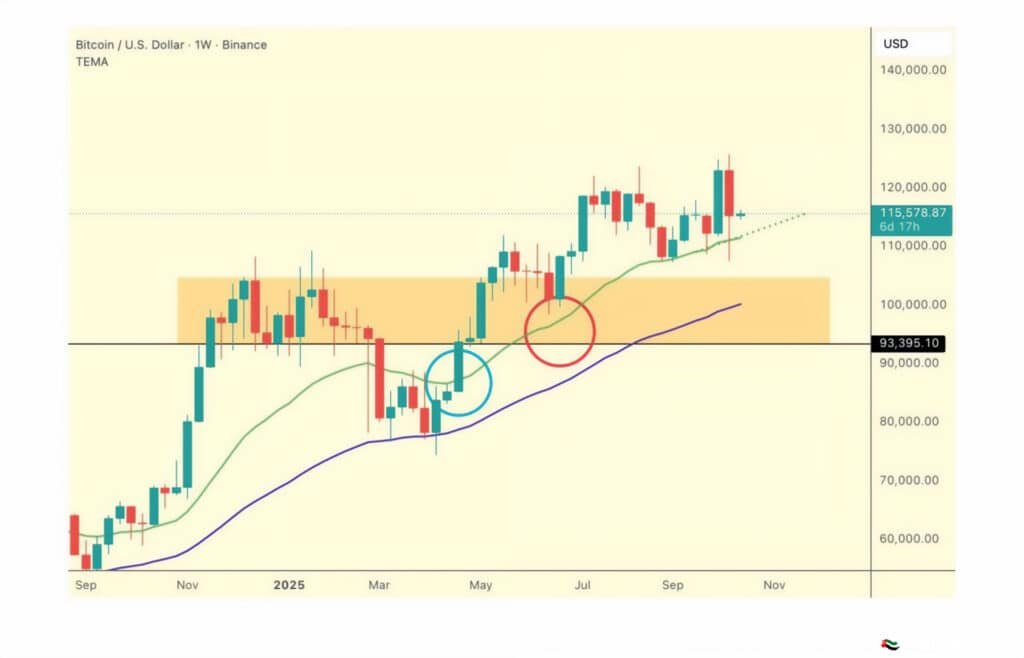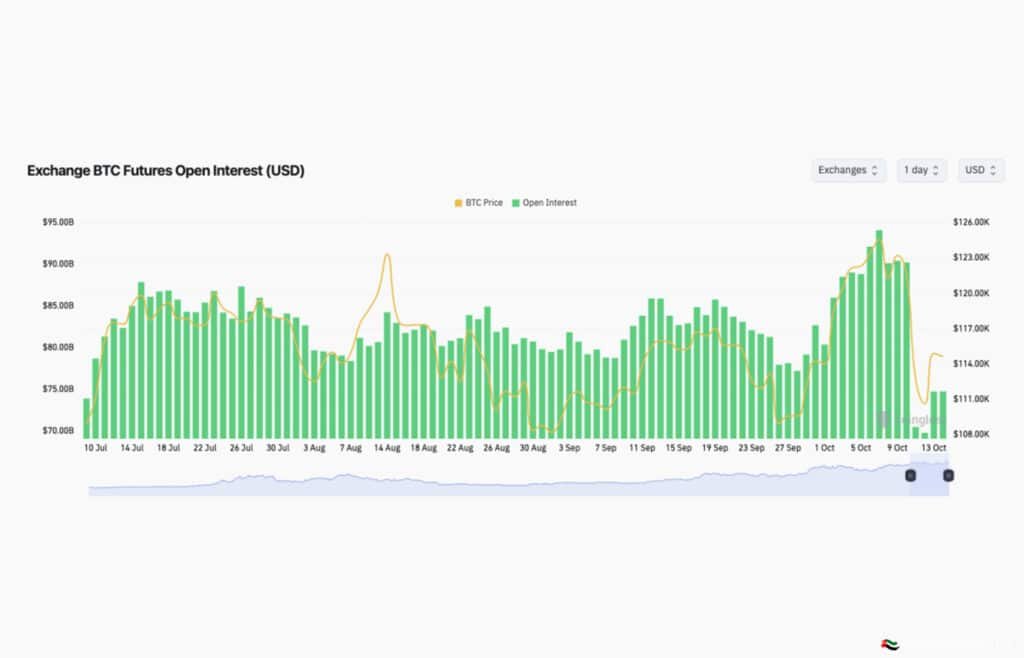Bitcoin just got hammered. Nineteen billion dollars in leveraged bets collapsed in days. The market dropped hard. Then it did something interesting—it bounced. Now it’s sitting comfortably above its 21-week moving average, which matters more than you’d think. Everyone’s asking the same question: can the Bitcoin price prediction 2025 actually hit all time highs?
The answer depends on understanding five specific forces reshaping Bitcoin’s trajectory right now. This isn’t speculation. It’s pattern recognition based on what professional traders actually watch.
The Technical Setup: The Line That Matters Most
Every serious Bitcoin rally since 2015 has one thing in common. It holds above the 21-week exponential moving average. Sounds boring. It’s actually crucial.
Think of it like this—when Bitcoin stays above that line, it signals the uptrend remains intact. When it breaks below, trouble usually follows. Right now, Bitcoin is sitting comfortably above it. Better yet, it’s creating a pattern called higher weekly lows, which repeats exactly during previous bull markets.
That repetition matters. Traders don’t just look at random charts. They search for patterns that worked before, then wait for them to appear again. This pattern is appearing right now.
Technical analysts are also spotting something called an inverse head-and-shoulders formation. If Bitcoin closes decisively above $117,800, that pattern completes. History suggests completion usually triggers a meaningful push higher. We’re talking potential moves toward $120,000 and beyond. Momentum indicators show buyers still dominate the medium-term picture, which keeps the odds favourable for further upside.

The Leverage Washout: Why the Crash Actually Helped
Last week’s $19 billion destruction wasn’t random destruction. It was necessary. Here’s why that matters.
The market had become dangerously overleveraged. Too many traders were using borrowed money, betting everything on continued upside. One bad candle and the whole thing collapsed. Stop-losses triggered. Margin calls executed. Weak hands capitulated.
From a market health perspective, that’s actually positive. Funding rates—the fees traders pay to hold leveraged positions—dropped to levels unseen since the 2022 bear market. Open interest fell by over $20 billion in just two days. That sounds catastrophic until you realise what it means: excessive leverage has been purged from the system.
Professional traders call this a “cleansing phase.” It removes weak speculation, creates space for fresh capital, and resets sentiment toward something more sustainable. Markets that crash hard after becoming overleveraged often bounce strongest. The fuel has been cleared. New buyers can enter without fighting against a sea of short-covering panic.
Volatility will remain elevated. Strong rallies can reverse just as quickly as they started. But the underlying structure has become healthier. That’s the definition of a bounce worth taking seriously.

The Macro Picture: The Federal Reserve Actually Matters
Bitcoin traders obsess over technical charts. Smart Bitcoin traders pay equal attention to what central banks are doing.
The US government briefly shut down, delaying inflation data. That might sound irrelevant. It’s not. Markets are now completely focused on the Federal Reserve’s next move. Most expect a 25-basis-point rate cut in late October. Whether Powell sounds optimistic or cautious matters more than the quarter-point itself.
A dovish Fed—one signalling comfort with rate cuts and easier conditions—typically boosts risk appetite across all asset classes. Bitcoin tends to lead that rally. A hawkish tone could stall enthusiasm immediately. Investors would rather hold cash than speculate on volatile assets if interest rates appear sticky.
Globally, the picture looks encouraging. Central banks worldwide are entering easing cycles. Liquidity is expanding. When money supply grows, digital assets historically perform well. Traders now compare Bitcoin’s price action directly against global M2 money supply—essentially, the total amount of money sloshing around the financial system.
That correlation is important. Bitcoin has lagged during periods of tight global conditions. If liquidity expansion continues into 2025, Bitcoin could finally “catch up” after being left behind for much of 2024. That catch-up move alone could justify prices between $130,000 and $150,000.
The Price Map: Where Actual Battles Happen
Technical traders aren’t making up random numbers. They’re watching where huge clusters of buy and sell orders sit on exchange order books.
Two zones dominate the current landscape. Support sits between $109,000 and $113,000. This zone is where buyers traditionally step in. It’s the floor. Below it, expect panic.
Resistance sits between $117,000 and $121,000. This zone is where sellers traditionally wait. It’s the ceiling. A daily close above $117,800 would signal that ceiling is breaking, potentially triggering acceleration toward $130,000 or higher.
Between these zones, volatility often deceives casual investors. Price can swing $5,000 in hours without meaningful direction. Professional traders stay patient during these swings. They wait for confirmation. That’s the edge.
The real risk lurks below $107,000. If Bitcoin drops through that level, it signals a deeper correction is underway. That would probably push prices back toward $100,000 or lower, negating all recent gains. Avoiding that outcome is the primary concern for bulls right now.
What Bitcoin Could Actually Reach in 2025
Most Wall Street research teams project Bitcoin trading between $115,000 and $145,000 by year-end 2025. That’s the consensus range. Some models are more aggressive.
CoinDesk‘s composite forecast suggests $150,000 becomes possible if rate cuts continue and ETF inflows accelerate. Cointelegraph’s analysts see potential for $160,000 in a full-strength bull cycle. More conservative voices, like Rosenberg Research, cap potential near $140,000, citing slower global growth concerns.
The reality is probably somewhere in the middle. Most likely scenario: Bitcoin consolidates around current levels for weeks or even months. Then, depending on two key variables—Fed policy tone and liquidity conditions through Asia and Europe—it either accelerates upward or remains trapped in consolidation.
Both variables currently lean supportive. That doesn’t guarantee anything. But the odds favour upside over downside for now.
The different outcomes break down like this. A base case scenario has Bitcoin rising gradually toward $115,000 to $135,000 as macro conditions stabilise. A bull case—aggressive but possible—sees $150,000 or higher driven by expansion of liquidity and strong ETF inflows. A bear case, less likely but real, drops prices back to $90,000 to $110,000 if inflation remains stubborn and the Fed stays hawkish.

Why Bitcoin Exists Beyond Price Predictions
Charts and predictions miss something fundamental. Bitcoin exists because investors fundamentally distrust fiat currency debasement.
When central banks expand balance sheets aggressively, the value of cash erodes. Investors seek assets that resist that erosion. Gold proved that concept for centuries. Bitcoin represents the modern digital equivalent.
Gold recently hit new record highs above $4,000 per ounce. Bitcoin, being more volatile and more speculative, typically follows with larger percentage moves. If inflation expectations rise again while interest rates fall—a scenario many analysts expect—Bitcoin could attract the same defensive capital that’s currently flowing into gold ETFs.
That “debasement trade” defined Bitcoin’s recovery through 2024. It continues guiding institutional positioning now. Understanding that thesis matters more than memorising technical levels. It explains why Bitcoin has recovered after every crash since 2012. The underlying reason to own it never actually disappeared.
How Serious Traders Actually Approach 2025
If you’re thinking about Bitcoin exposure in 2025, professional traders recommend a specific checklist. Keep positions modest until trend confirmation becomes obvious. Multiple smaller positions beat one large bet.
Use clear invalidation points before entering any position. Know exactly what price would prove you wrong. Bitcoin below $107,000 probably invalidates the bull case. Trade accordingly.
Avoid leverage entirely during macro announcements. The Fed speaks, price moves $2,000 in seconds, leveraged positions liquidate. That’s how nineteen billion dollars disappears. It’s not worth the risk.
Track liquidity flows through futures markets and spot ETF deposits. Large institutional money often telegraphs direction through these channels before price moves. Watching them provides early warning.
Take partial profits near major resistance levels. Euphoria never lasts. Booking profits near $117,000 or $125,000 lets you sleep at night. Greed is how traders turn gains into losses.
Most importantly: discipline beats aggression. Traders who survived 2022’s crash and 2024’s volatility learned that sustainability wins. Spectacle loses eventually. Trade accordingly.
The Dubai Angle: Regulation Creates Opportunity
The UAE has quietly built something significant. VARA’s licensing framework and DMCC’s crypto zones have transformed Dubai into a regulated hub for digital assets. That matters.
Family offices and professional investors in the Emirates increasingly use crypto as inflation hedges. Dubai-based platforms are preparing for larger flows if Bitcoin reaches new highs. The regulatory clarity means institutional capital feels comfortable deploying here.
If you’re in Dubai or the broader UAE, that’s actually advantageous. Regulated platforms offer safety that unregulated exchanges don’t. Use VARA-registered platforms. Document your compliance. Avoid leverage during volatility spikes.
As global capital rotates toward emerging hubs, the UAE is positioned to capture meaningful flows. That’s not speculation. That’s observation of current institutional behaviour.

The Bigger Picture: What Bitcoin Price Prediction 2025 Really Means
The Bitcoin prediction debate is never really about numbers. It’s about something deeper—how confidence, liquidity, and technology converge in real time.
Bitcoin has matured into a macro-sensitive asset class. It’s no longer pure speculation. It’s a digital barometer measuring collective trust in fiat money. Its resilience above the 21-week moving average proves that conviction remains strong, regardless of temporary crashes.
Here’s what probably happens. If global liquidity expands and inflation cools, Bitcoin trades between $130,000 and $150,000 before 2026 arrives. If growth falters or policy tightens unexpectedly, Bitcoin consolidates between $100,000 and $115,000 instead.
Either way, Bitcoin’s status as a borderless store of value feels irreversible now. Governments can’t stop it. Banks can’t ignore it anymore. Institutions can’t avoid it forever. That reality underpins everything. Price predictions are just details.
The real story is institutional Bitcoin ownership becoming normal. Regulatory clarity spreading. Capital rotations accelerating. That story probably has years to run.
Frequently Asked Questions
Most research teams project Bitcoin trading between $115,000 and $145,000 by year-end 2025. Aggressive forecasts suggest $150,000 to $160,000 if liquidity expands and ETF inflows accelerate. Conservative estimates cap potential around $140,000. Realistically, Bitcoin probably consolidates for weeks before making decisive moves. The outcome depends on Federal Reserve tone and global liquidity conditions.
The 21-week exponential moving average acts as a critical support level. Every major Bitcoin rally since 2015 has held above this line during bull markets. Currently, Bitcoin sits comfortably above it with higher weekly lows forming, which matches patterns from previous bull cycles. Breaking below this level would signal deeper correction risk, whilst staying above confirms the uptrend remains intact.
The crash purged excessive leverage from the system. Funding rates dropped to 2022 bear market lows. Open interest fell by over $20 billion in two days. Professional traders call this a “cleansing phase” that removes weak speculation and resets sentiment toward sustainability. Healthier market structure often precedes stronger rallies because the excess fuel has been cleared out.
Bitcoin responds significantly to Fed policy shifts. Dovish signals—suggesting rate cuts and easier liquidity—typically boost risk appetite and Bitcoin prices. Hawkish signals suggesting sticky inflation often stall enthusiasm. Global central bank easing cycles also correlate with Bitcoin performance. Traders monitor Fed communications closely because policy tone often matters more than actual rate movements themselves.



